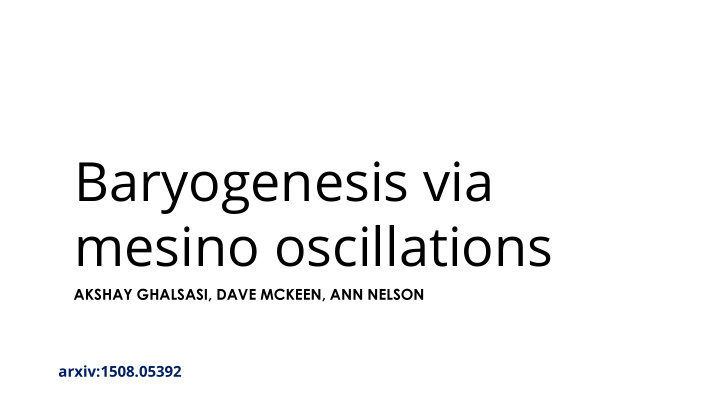



Baryogenesis via mesino oscillations AKSHAY GHALSASI, DAVE MCKEEN, ANN NELSON arxiv:1508.05392
The one minute summary 2 Mesino a bound state of colored scalar and quark Model analogous to Kaon system Mesinos form after the QCD hadronization temp Oscillations analogous to Kaon system give CP violation Baryon violating decays give baryogenesis
Outline 3 Introduction and Motivation The Model Oscillations and CP Asymmetry Experimental Constraints Cosmology Conclusion
4 Introduction and Motivation
Evidence for baryogenesis 5 Universe is made up of baryons
No baryogenesis in SM 6 Sakharov conditions • Baryon number violation ✓ (sphalerons) • C and CP Violation (CKM phase not enough) • Departure from thermal equilibrium (no first order PT ) Models of baryogenesis require high reheating temperature
Reheating temperature can be low 7 No evidence of high reheating temperature Many reasonable theories favor a low reheating scale • Gravitino production in SUSY extensions of SM (Moroi et al ‘83 ) • Isocurvature perturbations ( Fox et al ‘04 ) There do exist low scale baryogenesis models (Claudson et al ’84, Dimopolous et al ‘87 )
8 The Model
Particle content 9 singlet colored majorana fermions scalars mass N 2,3 O(TeV) N 1
Complex phases 10 all 9 phases real and remain diagonal two complex phases remain Oscillations and CP B violation violation
Decay Modes 11 d i * d i Antibaryon Baryon +mesons +mesons u* j u j s* s N 1 N 1 N 1 N 1 +mesons +mesons d i * d i s* s
12 Oscillations and CP Asymmetry
On-shell and off-shell oscillations 13 s* Off shell diagrams N 2 s N 2 O(TeV) N 1 s* On shell diagrams N 1 via common final states s
Off-shell contribution 14 s* Off shell oscillations 𝑁 12 : N 1,2 s Form factor N 2 Berger et al ‘13 N 1
On-shell contribution 15 Contributions to Γ 12 : s* s We want to be in the squeezed limit In squeezed limit one can show
Hamiltonian is not diagonal 16 Hamiltonian without oscillations With oscillations we get off diagonal terms
Diagonalizing the Hamiltonian 17 Hamiltonian has off diagonal terms, new eigenstates are Assuming a state starts as at t = 0 then CP violation gives favoring one state over another
CP asymmetry 18 Can show asymmetry per mesino-antimesino pair is given by branching ratio into baryons Lets define and then we have We expect generally Can show
19 Experimental Constraints
Experimental Signatures 20 d i 2 jets u j q soft quark, no jet d i 2 jets N 1 N 1 u j d k d i usually soft quark, no jet q soft quarks, no jet
Constraints on mass 21 Constraints from squarks decaying into b and light quark: (CMS) Effective constraints from squark decaying to light quarks: (CMS) Constraints from 3 jet events: We take as our benchmark value
Couplings 22 upper bounds from Kaon oscillations, 𝑜ത 𝑜 oscillations and upper bounds from 𝑜ത 𝑜 oscillations diinucleon decays, lower and dinucleon decays bounds from displaced vertices upper bound from cosmology
Constraints summary 23 Totally fine set of couplings for : Constraints only get weaker with increasing mass
24 Cosmology
Cosmic Story 25 T T = 200 MeV N 3 N 3 N 3 N 3 N s* s CP Violation Baryons Anti Baryons T = 1 MeV
N 3 does not annihilate 26 Number density of N 3 at hadronization temp T c For N 3 to last until T c we need Small Yukawa imply N 3 annihilations are slower than expansion rate. So most of the N 3 survives till T c
Exact Solution 27 We can coevolve the radiation, N 3 and baryons produced from their decay to get the exact solution
Sudden Decay Approximation 28 Baryon to entropy ratio in sudden decay approximation Ratio of matter and radiation energy densities for ent. dil. However and so
Constraints on decay rate 29
Asymmetry dependence on α 𝐶 30
Possible signatures 31 Finding colored scalars at LHC (1 TeV at 1000 fb -1 ) • final states jets will have third generation quarks • mostly 2-jet decays but will have 3-jets sometimes • possible displaced vertices signature • same sign tops (Berger ‘13) • CP violation in same sign tops hard to see at LHC Any signature needs to be consistent with neutron-antineutron oscillations and B meson and Kaon oscillations
Conclusions and future work 32 If there is a scalar quark it can form mesinos CP violation in mesino oscillations can be the source for baryogenesis In order to get enough CP violation we need the singlets to be very close in mass with mesinos
33 THANK YOU! QUESTIONS?
Constraints on couplings from 34 displaced vertices Displaced vertices search give us 𝑑τ < 1 𝑛𝑛 Φ → quarks : Φ → N 1 → quarks : These constraints don’t apply if Mass independent constraints from BBN are 𝑃 10 6 weaker
Constraints from Rare Processes 35 ∆B = 2 , neutron-antineutron oscillation: For we get Dinucleon to Kaon decay constraints for Easily satisfied if
Kaon oscillation constraints 36 s d N i N j d * s * Constraints from K L and K S mass difference Constraints from CP violation in Kaon system B meson oscillations aren’t as constraining
Recommend
More recommend